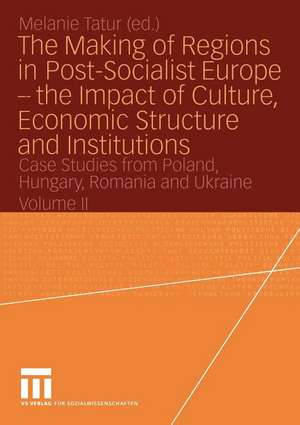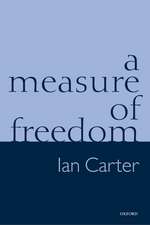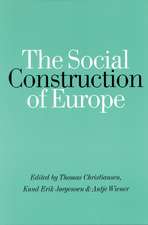The Making of Regions in Post-Socialist Europe — the Impact of Culture, Economic Structure and Institutions: Case Studies from Poland, Hungary, Romania and Ukraine Volume II
Editat de Melanie Taturen Limba Engleză Paperback – 29 apr 2004
| Toate formatele și edițiile | Preț | Express |
|---|---|---|
| Paperback (2) | 388.13 lei 6-8 săpt. | |
| VS Verlag für Sozialwissenschaften – 29 apr 2004 | 388.13 lei 6-8 săpt. | |
| VS Verlag für Sozialwissenschaften – 29 apr 2004 | 391.61 lei 6-8 săpt. |
Preț: 391.61 lei
Nou
Puncte Express: 587
Preț estimativ în valută:
74.93€ • 81.65$ • 63.14£
74.93€ • 81.65$ • 63.14£
Carte tipărită la comandă
Livrare economică 23 aprilie-07 mai
Preluare comenzi: 021 569.72.76
Specificații
ISBN-13: 9783810038142
ISBN-10: 3810038148
Pagini: 420
Ilustrații: 416 p. 23 illus.
Dimensiuni: 148 x 210 x 22 mm
Greutate: 0.5 kg
Ediția:2004
Editura: VS Verlag für Sozialwissenschaften
Colecția VS Verlag für Sozialwissenschaften
Locul publicării:Wiesbaden, Germany
ISBN-10: 3810038148
Pagini: 420
Ilustrații: 416 p. 23 illus.
Dimensiuni: 148 x 210 x 22 mm
Greutate: 0.5 kg
Ediția:2004
Editura: VS Verlag für Sozialwissenschaften
Colecția VS Verlag für Sozialwissenschaften
Locul publicării:Wiesbaden, Germany
Public țintă
ResearchCuprins
Content.- Romania’s Western Connection: Timisoara and Timis County.- Ukraine: the Genesis of a Captured State.- The Ukrainian Piedmont: Institutionalisation at the Borders of East Central Europe.- The Captured Region: Actors and Institutions in the Ukrainian Donbass.- L’viv and Donetsk: How Culture Matters.- Comparative Conclusion: Institutions, Socio-economic Structure, and History — Explaining Diversity in Making Regions.- References.
Notă biografică
Prof. Dr. Melanie Tatur, Fachbereich Gesellschaftswissenschaften, Johann Wolfgang Goethe-Universität Frankfurt am Main.
Textul de pe ultima copertă
The study combines the debate on regionalisation with transformation research. It regards the formation of regional actors and institutions not primarily from the perspective of formal organisational structures, but also a consequence of the macro-political transformation regime and region-specific opportunity structures. These structures include evonomic restrictions, historical legacies and cultural resources that are conveyed in present informal mechanisms, personal networks, discourses, and development strategies.
The qualitative empirical approach offers a vivid picture of regional developments. The two volumes cover Malopolska and Silesia (Poland), Hajdu-Bihar County (Hungary), Timis County (Romania), and the L'viv and Donetsk regions (Ukraine).
The qualitative empirical approach offers a vivid picture of regional developments. The two volumes cover Malopolska and Silesia (Poland), Hajdu-Bihar County (Hungary), Timis County (Romania), and the L'viv and Donetsk regions (Ukraine).
Caracteristici
Regional Policy in Eastern Europe










